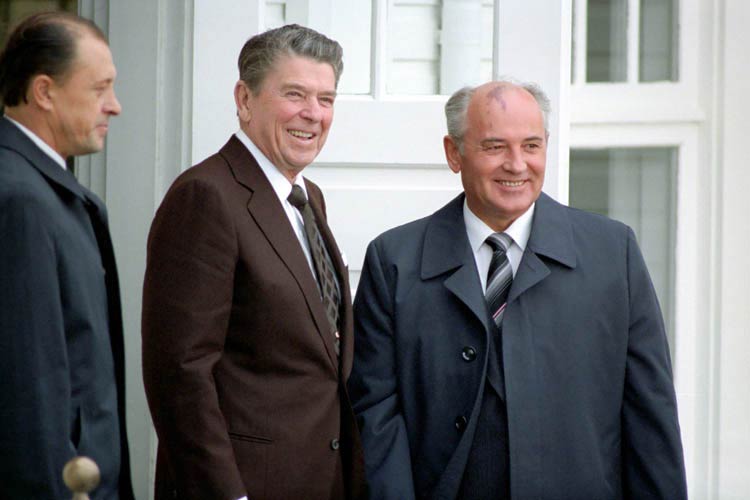Kim Jong Un (L) and US President Donald Trump depicted on a float in Germany – Credit: Lukas Schulze/Getty

President Trump’s abrupt cancellation of the Singapore summit on the denuclearisation of the Korean Peninsula was initially thought to have have been a diplomatic disaster. But was it really? Amid suggestions that talks may yet take place, it’s worth remembering that back in 1986, the failure of the Reykjavik Summit on arms control in 1986 actually hastened the end of the Cold War.
True, Donald Trump is not Ronald Reagan (though there were doubts in Europe about the former B-List actor’s capability), and Kim Jong-un is not Mikhail Gorbachev, but events in Reykjavik 32 years ago – which in strategic terms is only yesterday – are worth studying for their possible relevance today.
In 1985, Reagan and Gorbachev, who had become leader of the Soviet Union in March, met for the first time in Geneva. The purpose was to talk about the arms race, particularly the US’s Strategic Defense Initiative – “Star Wars” (an ICBM interception system) – which threatened the equilibrium of “Mutual Assured Destruction”. SDI was only in the theoretical and experimental stage, but Moscow knew that the US’s technological resources – not least money – were formidable.
The Geneva summit was held in November 1985 at a chateau owned by the Aga Khan, and the two leaders’ first meeting ran half an hour over schedule. A promising start. The two men had a cheery disposition (Gorbachev’s immediate predecessors, Konstantin Chernenko and Yuri Andropov, had been in the “old waxworks” category), and Gorbachev accepted Reagan’s invitation to visit the US.
The major outcome of Geneva, though, was the Reykjavik Summit, held in October the following year, 1986. The summit’s purpose was to explore the possibilities of reaching an agreement on arms control. However, while Gorbachev wanted an agreement on all ballistic missiles and to limit the talks to arms control, Reagan was determined to continue with SDI and also wanted to include talks on human rights, the emigration of Soviet Jews and dissidents, and the Soviet 1979 invasion of Afghanistan, a continuing source of East-West friction – issues that had been stuck in a time warp since Carter’s presidency. Inside the Washington beltway, however, there were many who were worried that Reagan would “give the store away” – ie SDI.
Reagan had views on how the Reykjavik summit should proceed. He thought Gorbachev might be a man he could do business with (Margaret Thatcher, the British prime minister, had said the same). Much to the consternation of Washington staffers, he insisted on starting with a private meeting with the Soviet leader plus interpreters.
Reagan’s thinking was straightforward: even with SDI, he believed a nuclear war could not be won and therefore must never be fought. Incredible as it now may seem (or perhaps not, given Donald Trump’s tweeted threats), this was by no means a universal view, and there was considerable planning for the waging of nuclear war, if only as a contingency in case deterrence failed.
Reagan believed that he and Gorbachev could identify areas of common interests, convinced as he was that the Soviet leader – like him – understood that his own people wanted prosperity and economic development. It followed logically that he and Gorbachev were best-placed to satisfy the demands of their people.
Sceptics in Washington and other Nato capitals did not share Reagan’s sunny optimism. The same was true of the KGB with their leader. Indeed, they were opposed to, and tried to block, the meetings, even though Gorbachev’s evolving doctrine of Perestroika and Glasnost. came originally from the KGB as a means of maintaining Communist Party control of the Russian state and the Soviet Union.
In fact, the KGB saw the greater threat to the continuation of party control as coming from the West, the US in particular, than from the internal contradictions of the Soviet economic system. Indeed, the obstacles to Reykjavik in Moscow were far greater than in Washington. The chances of the summit not coming off at all were high.
In the end it was Gorbachev and Eduard Shevardnadze (his foreign minister) who made sure it happened, as much as it was Reagan and Shultz.
At Reykjavik, Reagan’s basic message was that the US was prepared to give up offensive nuclear weapons over a period of time in order to establish a relationship based on defensive weapons, offering to share SDI technology – a sort of “Mutual Assured Protection”. In reply, a sceptical Gorbachev said he didn’t believe the US would even share milking machine technology with the USSR. On the subject of SDI, for the time being at least, Gorbachev and the KGB saw eye to eye.
While, however, offensive-defensive trade-offs were the central issue, there were also discussions in the margins on intermediate-range nuclear forces (INF)[2. These were intermediate-range ballistic missiles (IRBMs) and ground-launched cruise missiles (GLCMs), having ranges of 1,000 to 5,500 km (620 to 3,400 miles) and shorter-range ballistic missiles (SRBMs) with ranges from 500 to 1,000 km. The deployment of these in Europe had been a cause for concern since the late 1970s, when the Soviet Union began replacing its older single-warhead SS-4 and SS-5 IRBMs with newer and more accurate SS-20s, which could each deliver three nuclear warheads from a distance of 5,000 km. Mounted on mobile launchers based in the western Soviet Union, the SS-20 could strike targets anywhere in western Europe in less than 10 minutes.].
Nevertheless, over the central issue – which boiled down to SDI – the talks became increasingly acrimonious. At the end of the two-day meeting, Gorbachev refused to sign the proposed INF arms-reduction agreement because Reagan would not give up development of SDI:
We cannot go along with what you propose. If you will agree to banning tests in space, we will sign the document in two minutes. We cannot go along with something else. We have already agreed to what we could; we are not to blame. Even though our meeting is ending in this way, I have a clear conscience before my people and before you. I have done everything I could.
Reagan replied:
It’s too bad we have to part this way. We were so close to an agreement. I think you didn’t want to achieve an agreement anyway [emphasis added]. I’m very sorry.
The two leaders left the Hofdi House on the Reykjavik waterfront grim-faced, which the cameras soon conveyed to the world as the total failure of the summit.
However, six months later the finishing touches were being put to an INF agreement which reduced allowable missiles to zero. The summit was ultimately a failure in dealing with ICBMs, but the meeting had subtly changed the relationship.

Considerable progress had been made behind the scenes on how the US would deal with human rights issues between the two countries – the first time that the Soviet Union had ever allowed another country to become involved. Gorbachev has cited Reykjavik as the beginning of the end of the Cold War – though when exactly he realised this isn’t clear. Whatever the case, five years later the USSR was dissolved.
After Reykjavik, Gorbachev had gone from one European capital to another saying that it would have been possible to have a nuclear-free world if it hadn’t been for the American insistence on pursuing SDI. However, he had misjudged their mood, for the European members of Nato had been shaken by the potential agreement on the removal of INF missiles, which would have left them without any continental-based nuclear defence against the Red Army. INF missiles in Europe was a guarantee of US commitment in the event of a Soviet attack; no INF missiles on European soil equated to no guarantee.
In the US itself, luminaries such as Henry Kissinger and Zbigniew Brzezinski (President Carter’s national security adviser) also publically criticised Reagan and his team for their “recklessness” at Reykjavik in drawing down INF, predicting that the Europeans, seeing it as a withdrawal from Europe, would seek realignment, opening the possibility of an entirely new balance-of-power, one unfavourable to the US.
Eventually, however, Gorbachev came to accept that he would not be able to kill SDI, while the Europeans also came to see the benefits of reducing tensions by a “zero-zero” INF agreement: the withdrawal of all Soviet and US intermediate-range nuclear missiles from Europe. Washington became the venue for the next summit, in late 1987. Its centrepiece was the signing of the INF treaty on December 8. Reagan’s reputation in the West stood sky high.
The irony is that if there had been a far-reaching agreement at Reykjavik, it would almost certainly have been sabotaged by the bureaucracies in both capitals. The USSR might have been able to stagger on a few years more, with the threat of doing untold damage. Walking away, as Reagan did, had been courageous, and based on his clear central intellectual position. That it also proved smart is testimony to Gorbachev’s – eventual – pragmatism; and to what goes on behind the scenes when two sides are in proximity or approaching proximity.
In June 1988, with the INF treaty now in force, President Reagan went to Moscow, and Gorbachev took him to see some of the sights. As they were strolling arm in arm across Red Square, one of the accompanying media called out, “President Reagan, do you still think this is the ‘Evil Empire’?”
Reagan answered, “No, that was another time, another place.”
It remains to be seen if North Korea is ready to give up its “treasured sword of justice”. And it would be difficult to say that Trump has a clear, central, intellectual position. But after his startling cancellation, North Korea did issue a conciliatory statement indicating it was ready to “resolve problems at any time”. And news from Washington suggests that the talks may yet take place.
Looking forward to meeting with Kim Yong Chol in New York to discuss @Potus potential summit with Chairman Kim. We are committed to the complete, verifiable, and irreversible denuclearization of the Korean Peninsula @StateDept
— Secretary Pompeo (@SecPompeo) May 30, 2018
And they may fail. But as the power games in Washington and Pyongyang play out, before rushing to doomy conclusions, it’s worth remembering how impossible it was to conceive of Reagan and Gorbachev ever being arm in arm after the failure of Reykjavik.










Join the discussion
Join like minded readers that support our journalism by becoming a paid subscriber
To join the discussion in the comments, become a paid subscriber.
Join like minded readers that support our journalism, read unlimited articles and enjoy other subscriber-only benefits.
Subscribe